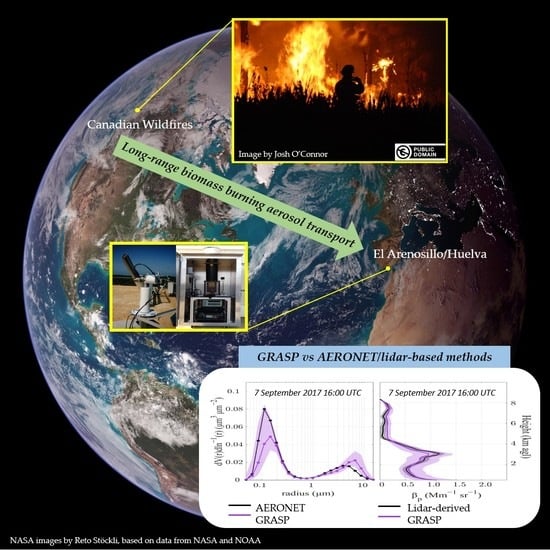Retrieval of Aged Biomass-Burning Aerosol Properties by Using GRASP Code in Synergy with Polarized Micro-Pulse Lidar and Sun/Sky Photometer
Abstract
:1. Introduction
2. Materials and Methods
2.1. Measurement Site and Instrumentation
2.2. Retrieval of Aerosol Properties
2.2.1. AERONET Products
2.2.2. Lidar-Based Algorithms
2.2.3. GRASP Retrieval
2.3. GRASP Evaluation: A Comparative Analysis
- A linear regression analysis between GRASP and AERONET/lidar-based results (constraining to zero the intersection value). Both the slope (m) and the correlation coefficient (r) are obtained, not only as a measure of the similarities between GRASP and AERONET models but also as a quantification of the model’s capability to reproduce the shape of the aerosol profiling.
- The mean fractional bias (MFB) for quantifying a possible under- or overestimation of the GRASP-derived products:where i represents the case study and Y is the variable to be compared (i.e., Y = Reff, VC, VSD, βp(z), VC(z)), G represents the GRASP-retrieved variable, M denotes AERONET or lidar-derived variable, and N is either the number of total cases (N = 10) for columnar properties or the number of total height bins (N = 60) for the vertical profiles.
- The total occurrence (χ) of either BB cases (for the GRASP/AERONET comparison) or the height-resolved level (for the GRASP/lidar comparison) fulfils an acceptable confidence value (±20%) of the relative differences (ΔrelY, in %):
2.4. Ancillary Information
3. Results
3.1. Selection of the Biomass-Burning Cases
3.2. Columnar Optical and Microphysical Properties
3.3. Height-Resolved Optical and Microphysical Properties
4. Discussion
4.1. Columnar Optical and Microphysical Properties
4.2. Height-Resolved Optical and Microphysical Properties
5. Conclusions
Author Contributions
Funding
Data Availability Statement
Acknowledgments
Conflicts of Interest
References
- Dubovik, O.; Lapyonok, T.; Litvinov, P.; Herman, M.; Fuertes, D.; Ducos, F.; Lopatin, A.; Chaikovsky, A.; Torres, B.; Derimian, Y. GRASP: A Versatile Algorithm for Characterizing the Atmosphere. SPIE Newsroom 2014, 25, 2-1201408. [Google Scholar] [CrossRef]
- Dubovik, O.; Fuertes, D.; Litvinov, P.; Lopatin, A.; Lapyonok, T.; Doubovik, I.; Xu, F.; Ducos, F.; Chen, C.; Torres, B.; et al. A Comprehensive Description of Multi-Term LSM for Applying Multiple a Priori Constraints in Problems of Atmospheric Remote Sensing: GRASP Algorithm, Concept, and Applications. Front. Remote Sens. 2021, 2, 706851. [Google Scholar] [CrossRef]
- Holben, B.N.; Eck, T.F.; Slutsker, I.; Tanre, D.; Buis, J.P.; Setzer, A.; Vermote, E.; Reagan, J.A.; Kaufman, Y.J.; Nakajima, T. AERONET—A Federated Instrument Network and Data Archive for Aerosol Characterization. Remote Sens. Environ. 1998, 66, 1–16. [Google Scholar] [CrossRef]
- Sinyuk, A.; Holben, B.N.; Eck, T.F.; Giles, D.M.; Slutsker, I.; Korkin, S.; Schafer, J.S.; Smirnov, A.; Sorokin, M.; Lyapustin, A. The AERONET Version 3 Aerosol Retrieval Algorithm, Associated Uncertainties and Comparisons to Version 2. Atmos. Meas. Tech. 2020, 13, 3375–3411. [Google Scholar] [CrossRef]
- Dubovik, O.; Herman, M.; Holdak, A.; Lapyonok, T.; Tanré, D.; Deuzé, J.L.; Ducos, F.; Sinyuk, A.; Lopatin, A. Statistically Optimized Inversion Algorithm for Enhanced Retrieval of Aerosol Properties from Spectral Multi-Angle Polarimetric Satellite Observations. Atmos. Meas. Tech. 2011, 4, 975–1018. [Google Scholar] [CrossRef] [Green Version]
- Lopatin, A.; Dubovik, O.; Chaikovsky, A.; Goloub, P.; Lapyonok, T.; Tanré, D.; Litvinov, P. Enhancement of Aerosol Characterization Using Synergy of Lidar and Sun-Photometer Coincident Observations: The GARRLiC Algorithm. Atmos. Meas. Tech. 2013, 6, 2065–2088. [Google Scholar] [CrossRef] [Green Version]
- Benavent-Oltra, J.A.; Román, R.; Casquero-Vera, J.A.; Pérez-Ramírez, D.; Lyamani, H.; Ortiz-Amezcua, P.; Bedoya-Velásquez, A.E.; de Arruda-Moreira, G.; Barreto, Á.; Lopatin, A. Different Strategies to Retrieve Aerosol Properties at Night-Time with the GRASP Algorithm. Atmos. Chem. Phys. 2019, 19, 14149–14171. [Google Scholar] [CrossRef] [Green Version]
- Soupiona, O.; Samaras, S.; Ortiz-Amezcua, P.; Böckmann, C.; Papayannis, A.; Moreira, G.A.; Benavent-Oltra, J.A.; Guerrero-Rascado, J.L.; Bedoya-Velásquez, A.E.; Olmo, F.J.; et al. Retrieval of Optical and Microphysical Properties of Transported Saharan Dust over Athens and Granada Based on Multi-Wavelength Raman Lidar Measurements: Study of the Mixing Processes. Atmos. Environ. 2019, 214, 116824. [Google Scholar] [CrossRef]
- Müller, D.; Hostetler, C.A.; Ferrare, R.A.; Burton, S.P.; Chemyakin, E.; Kolgotin, A.; Hair, J.W.; Cook, A.L.; Harper, D.B.; Rogers, R.R.; et al. Airborne Multiwavelength High Spectral Resolution Lidar (HSRL-2) Observations during TCAP 2012: Vertical Profiles of Optical and Microphysical Properties of a Smoke/Urban Haze Plume over the Northeastern Coast of the US. Atmos. Meas. Tech. 2014, 7, 3487–3496. [Google Scholar] [CrossRef] [Green Version]
- Pérez-Ramírez, D.; Whiteman, D.N.; Veselovskii, I.; Colarco, P.; Korenski, M.; da Silva, A. Retrievals of Aerosol Single Scattering Albedo by Multiwavelength Lidar Measurements: Evaluations with NASA Langley HSRL-2 during Discover-AQ Field Campaigns. Remote Sens. Environ. 2019, 222, 144–164. [Google Scholar] [CrossRef] [Green Version]
- Román, R.; Benavent-Oltra, J.A.; Casquero-Vera, J.A.; Lopatin, A.; Cazorla, A.; Lyamani, H.; Denjean, C.; Fuertes, D.; Pérez-Ramírez, D.; Torres, B. Retrieval of Aerosol Profiles Combining Sunphotometer and Ceilometer Measurements in GRASP Code. Atmos. Res. 2018, 204, 161–177. [Google Scholar] [CrossRef] [Green Version]
- Lopatin, A.; Dubovik, O.; Fuertes, D.; Stenchikov, G.; Lapyonok, T.; Veselovskii, I.; Wienhold, F.G.; Shevchenko, I.; Hu, Q.; Parajuli, S. Synergy Processing of Diverse Ground-Based Remote Sensing and in Situ Data Using the GRASP Algorithm: Applications to Radiometer, Lidar and Radiosonde Observations. Atmos. Meas. Tech. 2021, 14, 2575–2614. [Google Scholar] [CrossRef]
- López-Cayuela, M.-Á.; Herreras-Giralda, M.; Córdoba-Jabonero, C.; Lopatin, A.; Dubovik, O.; Guerrero-Rascado, J.L. Vertical Assessment of the Mineral Dust Optical and Microphysical Properties as Retrieved from the Synergy between Polarized Micro-Pulse Lidar and Sun/Sky Photometer Observations Using GRASP Code. Atmos. Res. 2021, 264, 105818. [Google Scholar] [CrossRef]
- Parajuli, S.P.; Stenchikov, G.L.; Ukhov, A.; Shevchenko, I.; Dubovik, O.; Lopatin, A. Aerosol Vertical Distribution and Interactions with Land/Sea Breezes over the Eastern Coast of the Red Sea from Lidar Data and High-Resolution WRF-Chem Simulations. Atmos. Chem. Phys. 2020, 20, 16089–16116. [Google Scholar] [CrossRef]
- Andreae, M.O. Emission of Trace Gases and Aerosols from Biomass Burning–an Updated Assessment. Atmos. Chem. Phys. 2019, 19, 8523–8546. [Google Scholar] [CrossRef] [Green Version]
- Bond, T.C.; Doherty, S.J.; Fahey, D.W.; Forster, P.M.; Berntsen, T.; DeAngelo, B.J.; Flanner, M.G.; Ghan, S.; Kärcher, B.; Koch, D.; et al. Bounding the Role of Black Carbon in the Climate System: A Scientific Assessment. J. Geophys. Res. Atmos. 2013, 118, 5380–5552. [Google Scholar] [CrossRef]
- Myhre, G.; Samset, B.H.; Schulz, M.; Balkanski, Y.; Bauer, S.; Berntsen, T.K.; Bian, H.; Bellouin, N.; Chin, M.; Diehl, T.; et al. Radiative Forcing of the Direct Aerosol Effect from AeroCom Phase II Simulations. Atmos. Chem. Phys. 2013, 13, 1853–1877. [Google Scholar] [CrossRef] [Green Version]
- Giordano, M.; Espinoza, C.; Asa-Awuku, A. Experimentally Measured Morphology of Biomass Burning Aerosol and Its Impacts on CCN Ability. Atmos. Chem. Phys. 2015, 15, 1807–1821. [Google Scholar] [CrossRef] [Green Version]
- Prenni, A.J.; DeMott, P.J.; Sullivan, A.P.; Sullivan, R.C.; Kreidenweis, S.M.; Rogers, D.C. Biomass Burning as a Potential Source for Atmospheric Ice Nuclei: Western Wildfires and Prescribed Burns. Geophys. Res. Lett. 2012, 39, 11. [Google Scholar] [CrossRef] [Green Version]
- Peterson, D.A.; Hyer, E.J.; Campbell, J.R.; Solbrig, J.E.; Fromm, M.D. A Conceptual Model for Development of Intense Pyrocumulonimbus in Western North America. Mon. Weather Rev. 2017, 145, 2235–2255. [Google Scholar] [CrossRef]
- Fromm, M.; Lindsey, D.T.; Servranckx, R.; Yue, G.; Trickl, T.; Sica, R.; Doucet, P.; Godin-Beekmann, S. The Untold Story of Pyrocumulonimbus. Bull. Am. Meteorol. Soc. 2010, 91, 1193–1210. [Google Scholar] [CrossRef] [Green Version]
- Das, S.; Colarco, P.R.; Oman, L.D.; Taha, G.; Torres, O. The Long-Term Transport and Radiative Impacts of the 2017 British Columbia Pyrocumulonimbus Smoke Aerosols in the Stratosphere. Atmos. Chem. Phys. 2021, 21, 12069–12090. [Google Scholar] [CrossRef]
- Peterson, D.A.; Campbell, J.R.; Hyer, E.J.; Fromm, M.D.; Kablick, G.P.; Cossuth, J.H.; DeLand, M.T. Wildfire-Driven Thunderstorms Cause a Volcano-like Stratospheric Injection of Smoke. Npj Clim. Atmos. Sci. 2018, 1, 1–8. [Google Scholar] [CrossRef] [Green Version]
- Pérez-Ramírez, D.; Andrade-Flores, M.; Eck, T.F.; Stein, A.F.; O’Neill, N.T.; Lyamani, H.; Gassó, S.; Whiteman, D.N.; Veselovskii, I.; Velarde, F.; et al. Multi Year Aerosol Characterization in the Tropical Andes and in Adjacent Amazonia Using AERONET Measurements. Atmos. Environ. 2017, 166, 412–432. [Google Scholar] [CrossRef] [Green Version]
- Calì Quaglia, F.; Meloni, D.; Muscari, G.; Di Iorio, T.; Ciardini, V.; Pace, G.; Becagli, S.; Di Bernardino, A.; Cacciani, M.; Hannigan, J.W.; et al. On the Radiative Impact of Biomass-Burning Aerosols in the Arctic: The August 2017 Case Study. Remote Sens. 2022, 14, 313. [Google Scholar] [CrossRef]
- Ansmann, A.; Baars, H.; Chudnovsky, A.; Mattis, I.; Veselovskii, I.; Haarig, M.; Seifert, P.; Engelmann, R.; Wandinger, U. Extreme Levels of Canadian Wildfire Smoke in the Stratosphere over Central Europe on 21–22 August 2017. Atmos. Chem. Phys. 2018, 18, 11831–11845. [Google Scholar] [CrossRef] [Green Version]
- Baars, H.; Ansmann, A.; Ohneiser, K.; Haarig, M.; Engelmann, R.; Althausen, D.; Hanssen, I.; Gausa, M.; Pietruczuk, A.; Szkop, A.; et al. The Unprecedented 2017–2018 Stratospheric Smoke Event: Decay Phase and Aerosol Properties Observed with the EARLINET. Atmos. Chem. Phys. 2019, 19, 15183–15198. [Google Scholar] [CrossRef] [Green Version]
- Haarig, M.; Ansmann, A.; Baars, H.; Jimenez, C.; Veselovskii, I.; Engelmann, R.; Althausen, D. Depolarization and lidar ratios at 355, 532, and 1064 nm and microphysical properties of aged tropospheric and stratospheric Canadian wildfire smoke. Atmos. Chem. Phys. 2018, 18, 11847–11861. [Google Scholar] [CrossRef] [Green Version]
- Hu, Q.; Goloub, P.; Veselovskii, I.; Bravo-Aranda, J.-A.; Popovici, I.E.; Podvin, T.; Haeffelin, M.; Lopatin, A.; Dubovik, O.; Pietras, C. Long-Range-Transported Canadian Smoke Plumes in the Lower Stratosphere over Northern France. Atmos. Chem. Phys. 2019, 19, 1173–1193. [Google Scholar] [CrossRef] [Green Version]
- Khaykin, S.M.; Godin-Beekmann, S.; Hauchecorne, A.; Pelon, J.; Ravetta, F.; Keckhut, P. Stratospheric Smoke With Unprecedentedly High Backscatter Observed by Lidars Above Southern France. Geophys. Res. Lett. 2018, 45, 1639–1646. [Google Scholar] [CrossRef]
- Torres, O.; Bhartia, P.K.; Taha, G.; Jethva, H.; Das, S.; Colarco, P.; Krotkov, N.; Omar, A.; Ahn, C. Stratospheric Injection of Massive Smoke Plume From Canadian Boreal Fires in 2017 as Seen by DSCOVR-EPIC, CALIOP, and OMPS-LP Observations. J. Geophys. Res. Atmos. 2020, 125, e2020JD032579. [Google Scholar] [CrossRef]
- Sicard, M.; Granados-Muñoz, M.J.; Alados-Arboledas, L.; Barragán, R.; Bedoya-Velásquez, A.E.; Benavent-Oltra, J.A.; Bortoli, D.; Comerón, A.; Córdoba-Jabonero, C.; Costa, M.J.; et al. Ground/Space, Passive/Active Remote Sensing Observations Coupled with Particle Dispersion Modelling to Understand the Inter-Continental Transport of Wildfire Smoke Plumes. Remote Sens. Environ. 2019, 232, 111294. [Google Scholar] [CrossRef] [Green Version]
- Alados-Arboledas, L.; Müller, D.; Guerrero-Rascado, J.L.; Navas-Guzmán, F.; Pérez-Ramírez, D.; Olmo, F.J. Optical and Microphysical Properties of Fresh Biomass Burning Aerosol Retrieved by Raman Lidar, and Star-and Sun-Photometry. Geophys. Res. Lett. 2011, 38, 1. [Google Scholar] [CrossRef]
- Pereira, S.N.; Preißler, J.; Guerrero-Rascado, J.L.; Silva, A.M.; Wagner, F. Forest Fire Smoke Layers Observed in the Free Troposphere over Portugal with a Multiwavelength Raman Lidar: Optical and Microphysical Properties. Sci. World J. 2014, 2014, e421838. [Google Scholar] [CrossRef]
- Salgueiro, V.; Costa, M.J.; Guerrero-Rascado, J.L.; Couto, F.T.; Bortoli, D. Characterization of Forest Fire and Saharan Desert Dust Aerosols over South-Western Europe Using a Multi-Wavelength Raman Lidar and Sun-Photometer. Atmos. Environ. 2021, 252, 118346. [Google Scholar] [CrossRef]
- Ortiz-Amezcua, P.; Guerrero-Rascado, J.L.; Granados-Muñoz, M.J.; Benavent-Oltra, J.A.; Böckmann, C.; Samaras, S.; Stachlewska, I.S.; Janicka, Ł.; Baars, H.; Bohlmann, S.; et al. Microphysical Characterization of Long-Range Transported Biomass Burning Particles from North America at Three EARLINET Stations. Atmos. Chem. Phys. 2017, 17, 5931–5946. [Google Scholar] [CrossRef] [Green Version]
- Veselovskii, I.; Whiteman, D.N.; Korenskiy, M.; Suvorina, A.; Kolgotin, A.; Lyapustin, A.; Wang, Y.; Chin, M.; Bian, H.; Kucsera, T.L.; et al. Characterization of Forest Fire Smoke Event near Washington, DC in Summer 2013 with Multi-Wavelength Lidar. Atmos. Chem. Phys. 2015, 15, 1647–1660. [Google Scholar] [CrossRef] [Green Version]
- Cayuela, M.Á.L.; Córdoba-Jabonero, C.; Pérez-Ramírez, D.; Herrera, M.; Guerrero-Rascado, J.L. GRASP retrievals in synergy with both polarized Micro-Pulse Lidar and Sun/Sky photometer measurements to derive optical and microphysical properties of aged smoke plumes. In Remote Sensing of Clouds and the Atmosphere XXVI; SPIE: Bellingham, WA, USA, 2021; Volume 11859, pp. 79–89. [Google Scholar]
- Toledano, C.; Cachorro, V.E.; Frutos, A.M.; Torres, B.; Berjón, A.; Sorribas, M.; Stone, R.S. Airmass Classification and Analysis of Aerosol Types at El Arenosillo (Spain). J. Appl. Meteorol. Climatol. 2009, 48, 962–981. [Google Scholar] [CrossRef]
- Campbell, J.R.; Hlavka, D.L.; Welton, E.J.; Flynn, C.J.; Turner, D.D.; Spinhirne, J.D.; Scott, V.S.; Hwang, I.H. Full-Time, Eye-Safe Cloud and Aerosol Lidar Observation at Atmospheric Radiation Measurement Program Sites: Instruments and Data Processing. J. Atmos. Ocean. Technol. 2002, 19, 431–442. [Google Scholar] [CrossRef]
- Córdoba-Jabonero, C.; Sicard, M.; Ansmann, A.; Águila, A.; Baars, H. Separation of the Optical and Mass Features of Particle Components in Different Aerosol Mixtures by Using POLIPHON Retrievals in Synergy with Continuous Polarized Micro-Pulse Lidar (P-MPL) Measurements. Atmos. Meas. Tech. 2018, 11, 4775–4795. [Google Scholar] [CrossRef] [Green Version]
- Flynn, C.J.; Mendoza, A.; Zheng, Y.; Mathur, S. Novel Polarization-Sensitive Micropulse Lidar Measurement Technique. Opt. Express 2007, 15, 2785–2790. [Google Scholar] [CrossRef]
- Welton, E.J.; Campbell, J.R. Micropulse Lidar Signals: Uncertainty Analysis. J. Atmos. Ocean. Technol. 2002, 19, 2089–2094. [Google Scholar] [CrossRef]
- Córdoba-Jabonero, C.; Ansmann, A.; Jiménez, C.; Baars, H.; López-Cayuela, M.-Á.; Engelmann, R. Experimental Assessment of a Micro-Pulse Lidar System in Comparison with Reference Lidar Measurements for Aerosol Optical Properties Retrieval. Atmos. Meas. Tech. 2021, 14, 5225–5239. [Google Scholar] [CrossRef]
- Estellés, V.; Utrillas, M.P.; Martínez-Lozano, J.A.; Alcántara, A.; Alados-Arboledas, L.; Olmo, F.J.; Lorente, J.; Cabo, X.; Cachorro, V.; Horvath, H.; et al. Intercomparison of Spectroradiometers and Sun Photometers for the Determination of the Aerosol Optical Depth during the VELETA-2002 Field Campaign. J. Geophys. Res. Atmos. 2006, 111, D17. [Google Scholar] [CrossRef] [Green Version]
- Giles, D.M.; Sinyuk, A.; Sorokin, M.G.; Schafer, J.S.; Smirnov, A.; Slutsker, I.; Eck, T.F.; Holben, B.N.; Lewis, J.R.; Campbell, J.R.; et al. Advancements in the Aerosol Robotic Network (AERONET) Version 3 Database–Automated near-Real-Time Quality Control Algorithm with Improved Cloud Screening for Sun Photometer Aerosol Optical Depth (AOD) Measurements. Atmos. Meas. Tech. 2019, 12, 169–209. [Google Scholar] [CrossRef] [Green Version]
- Wagner, F.; Silva, A.M. Some considerations about Ångström exponent distributions. Atmos. Chem. Phys. 2008, 8, 481–489. [Google Scholar] [CrossRef] [Green Version]
- Dubovik, O.; Smirnov, A.; Holben, B.N.; King, M.D.; Kaufman, Y.J.; Eck, T.F.; Slutsker, I. Accuracy Assessments of Aerosol Optical Properties Retrieved from Aerosol Robotic Network (AERONET) Sun and Sky Radiance Measurements. J. Geophys. Res. Atmos. 2000, 105, 9791–9806. [Google Scholar] [CrossRef] [Green Version]
- Fernald, F.G. Analysis of Atmospheric Lidar Observations: Some Comments. Appl. Opt. 1984, 23, 652–653. [Google Scholar] [CrossRef]
- Klett, J.D. Lidar Inversion with Variable Backscatter/Extinction Ratios. Appl. Opt. 1985, 24, 1638–1643. [Google Scholar] [CrossRef]
- Mamouri, R.-E.; Ansmann, A. Potential of Polarization/Raman Lidar to Separate Fine Dust, Coarse Dust, Maritime, and Anthropogenic Aerosol Profiles. Atmos. Meas. Tech. 2017, 10, 3403–3427. [Google Scholar] [CrossRef] [Green Version]
- Groß, S.; Esselborn, M.; Weinzierl, B.; Wirth, M.; Fix, A.; Petzold, A. Aerosol Classification by Airborne High Spectral Resolution Lidar Observations. Atmos. Chem. Phys. 2013, 13, 2487–2505. [Google Scholar] [CrossRef] [Green Version]
- Córdoba-Jabonero, C.; Sicard, M.; López-Cayuela, M.-Á.; Ansmann, A.; Comerón, A.; Zorzano, M.-P.; Rodríguez-Gómez, A.; Muñoz-Pocar, C. Aerosol Radiative Effect during the Summer 2019 Heatwave Produced Partly by an Inter-Continental Saharan Dust Outbreak. 1. Shortwave Dust-Induced Direct Impact. Atmos. Chem. Phys. 2021, 21, 6455–6479. [Google Scholar] [CrossRef]
- Ansmann, A.; Ohneiser, K.; Mamouri, R.-E.; Knopf, D.A.; Veselovskii, I.; Baars, H.; Engelmann, R.; Foth, A.; Jimenez, C.; Seifert, P.; et al. Tropospheric and Stratospheric Wildfire Smoke Profiling with Lidar: Mass, Surface Area, CCN, and INP Retrieval. Atmos. Chem. Phys. 2021, 21, 9779–9807. [Google Scholar] [CrossRef]
- Herrera, M.E.; Dubovik, O.; Torres, B.; Lapyonok, T.; Fuertes, D.; Lopatin, A.; Litvinov, P.; Chen, C.; Benavent-Oltra, J.A.; Bali, J.L.; et al. Estimates of the Remote Sensing Retrieval Errors by GRASP Algorithm: Application to Ground-Based Observations, Concept and Validation. Atmos. Meas. Tech. Discuss. 2022, 1–88. [Google Scholar] [CrossRef]
- Rolph, G.; Stein, A.; Stunder, B. Real-Time Environmental Applications and Display System: READY. Environ. Model. Softw. 2017, 95, 210–228. [Google Scholar] [CrossRef]
- Dubovik, O.; Holben, B.; Eck, T.F.; Smirnov, A.; Kaufman, Y.J.; King, M.D.; Tanré, D.; Slutsker, I. Variability of Absorption and Optical Properties of Key Aerosol Types Observed in Worldwide Locations. J. Atmos. Sci. 2002, 59, 590–608. [Google Scholar] [CrossRef]
- Müller, D.; Mattis, I.; Ansmann, A.; Wandinger, U.; Ritter, C.; Kaiser, D. Multiwavelenght Raman lidar observations of particle growth during long-range transport of forest-fire smoke in the free troposphere. Geophis. Res. Lett. 2007, 34, L05803. [Google Scholar] [CrossRef]
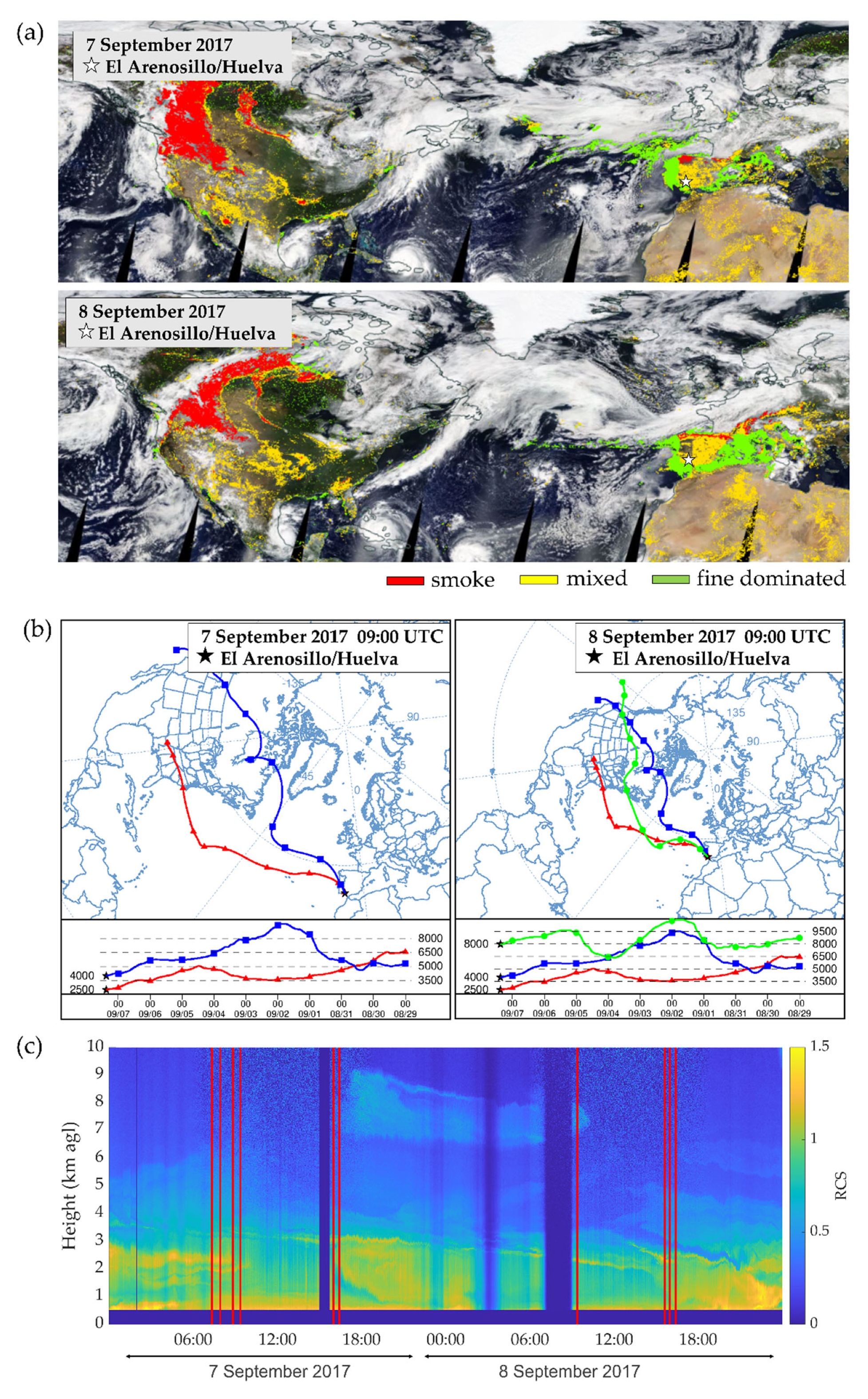
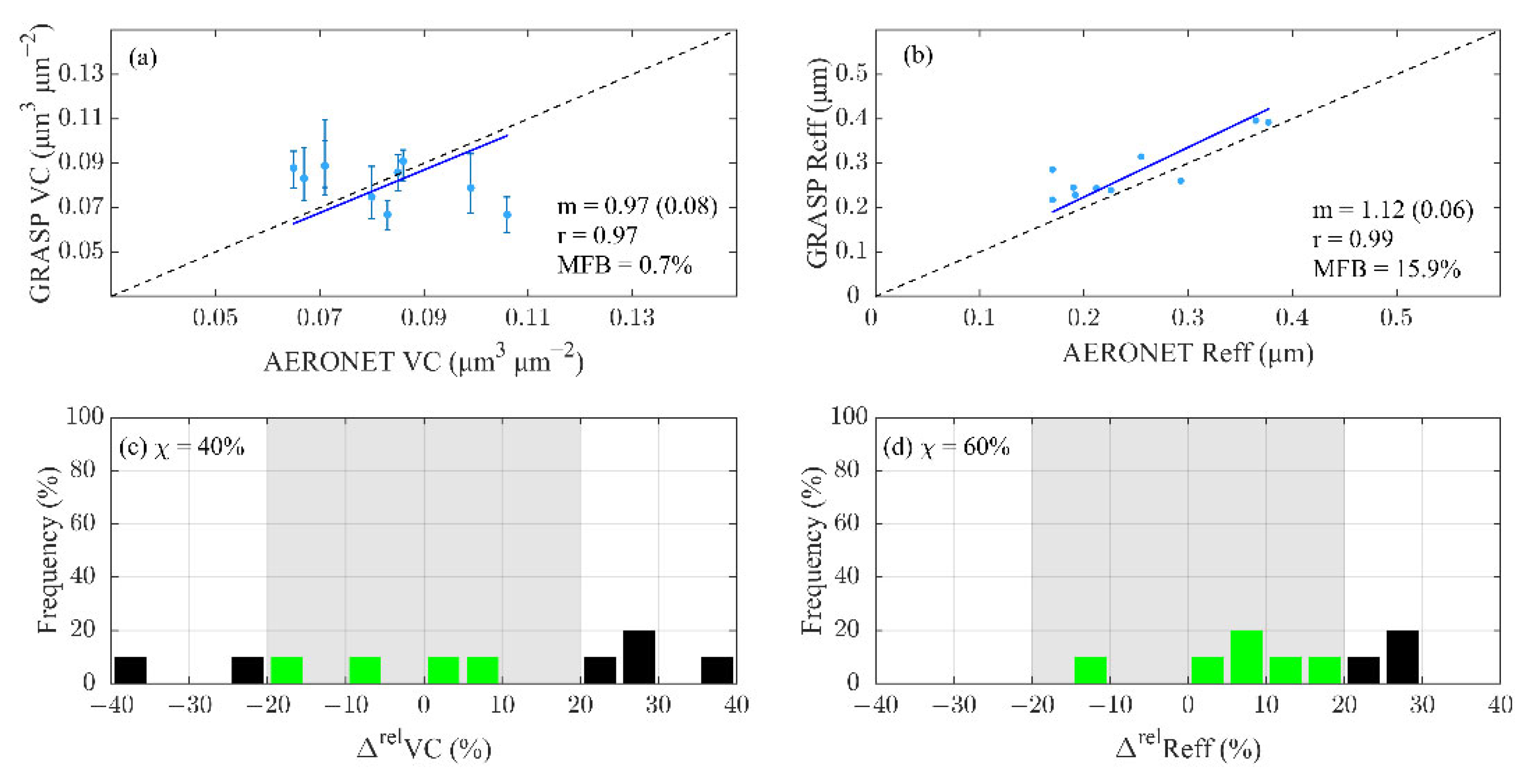
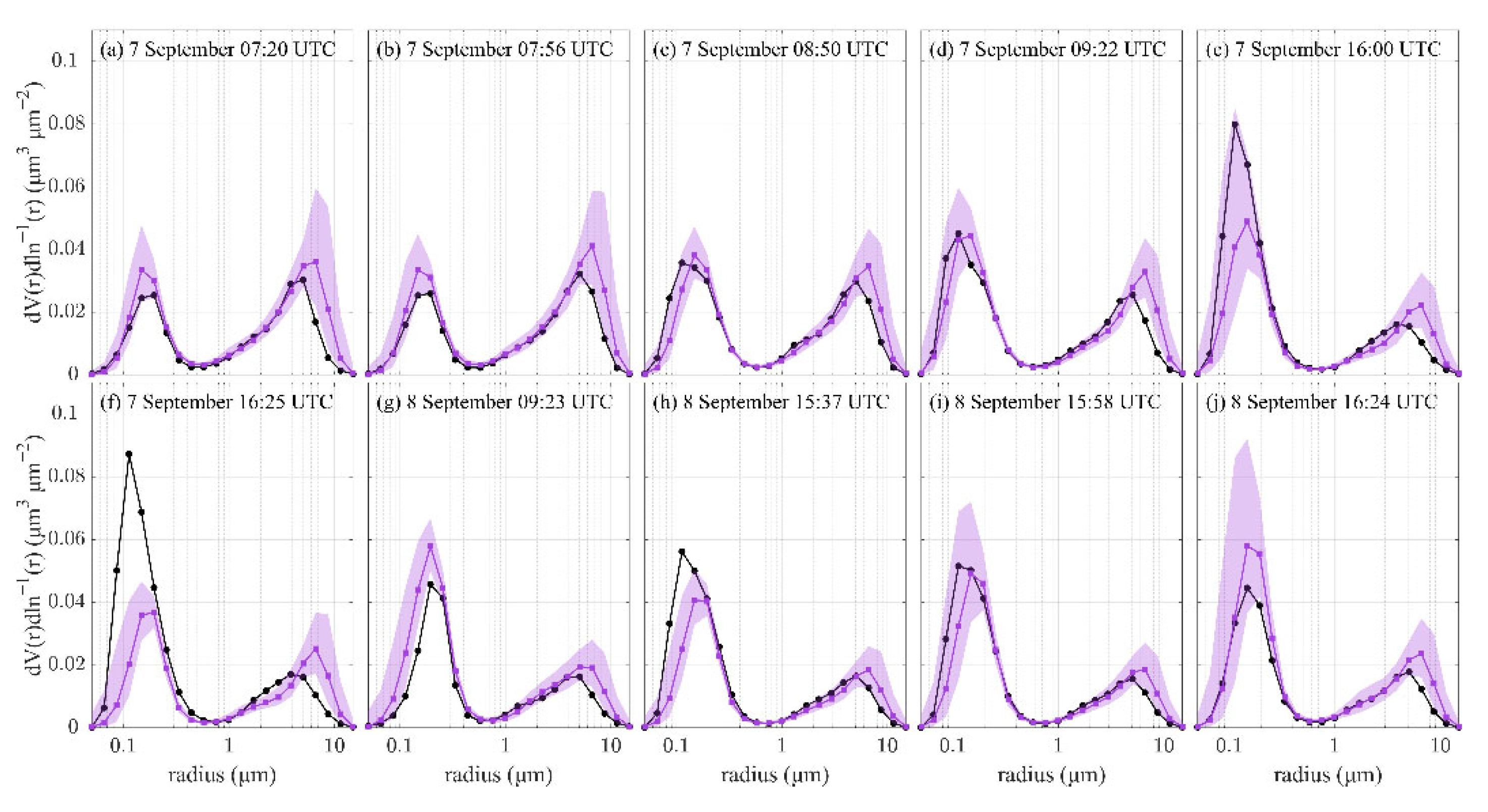
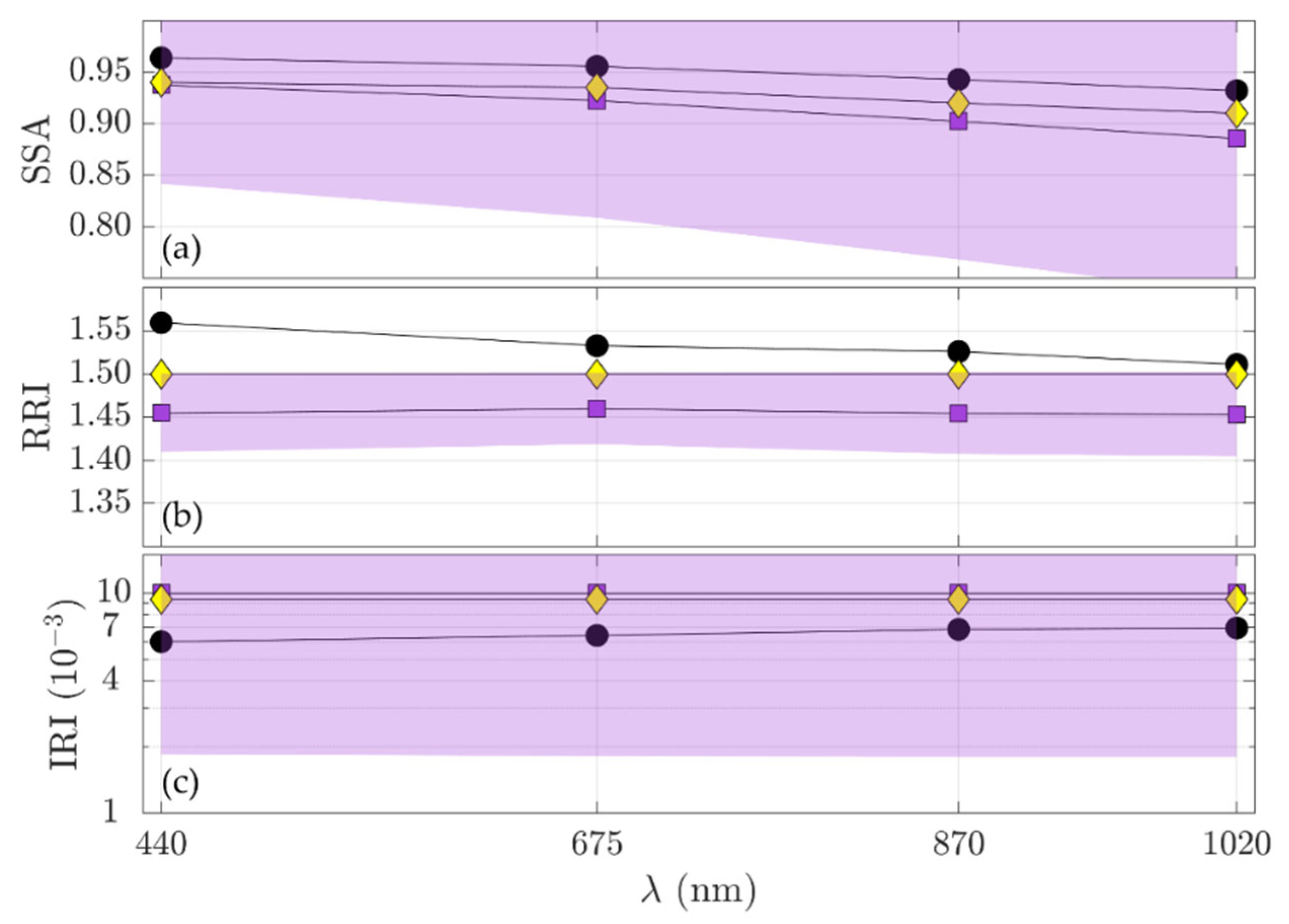
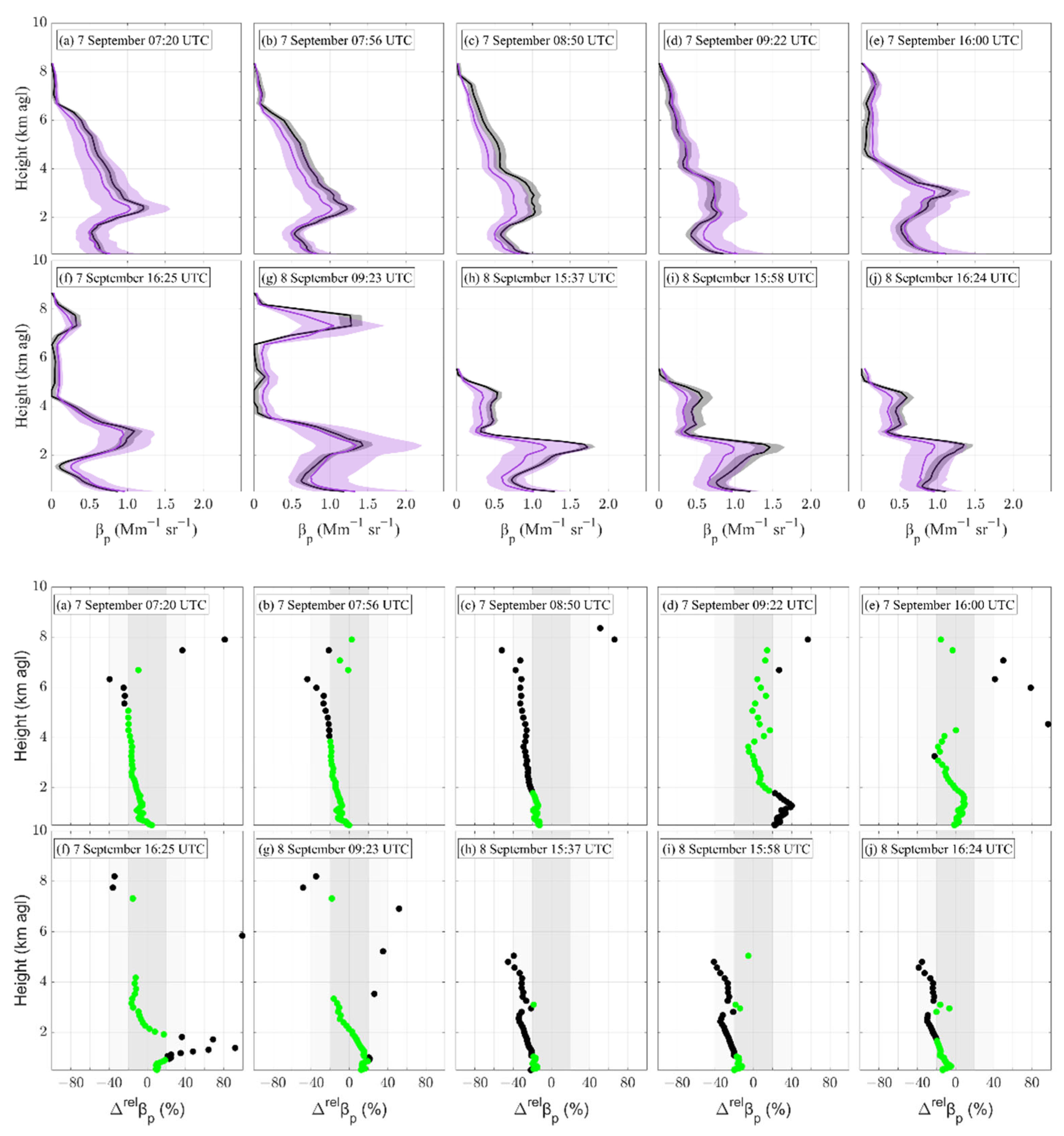
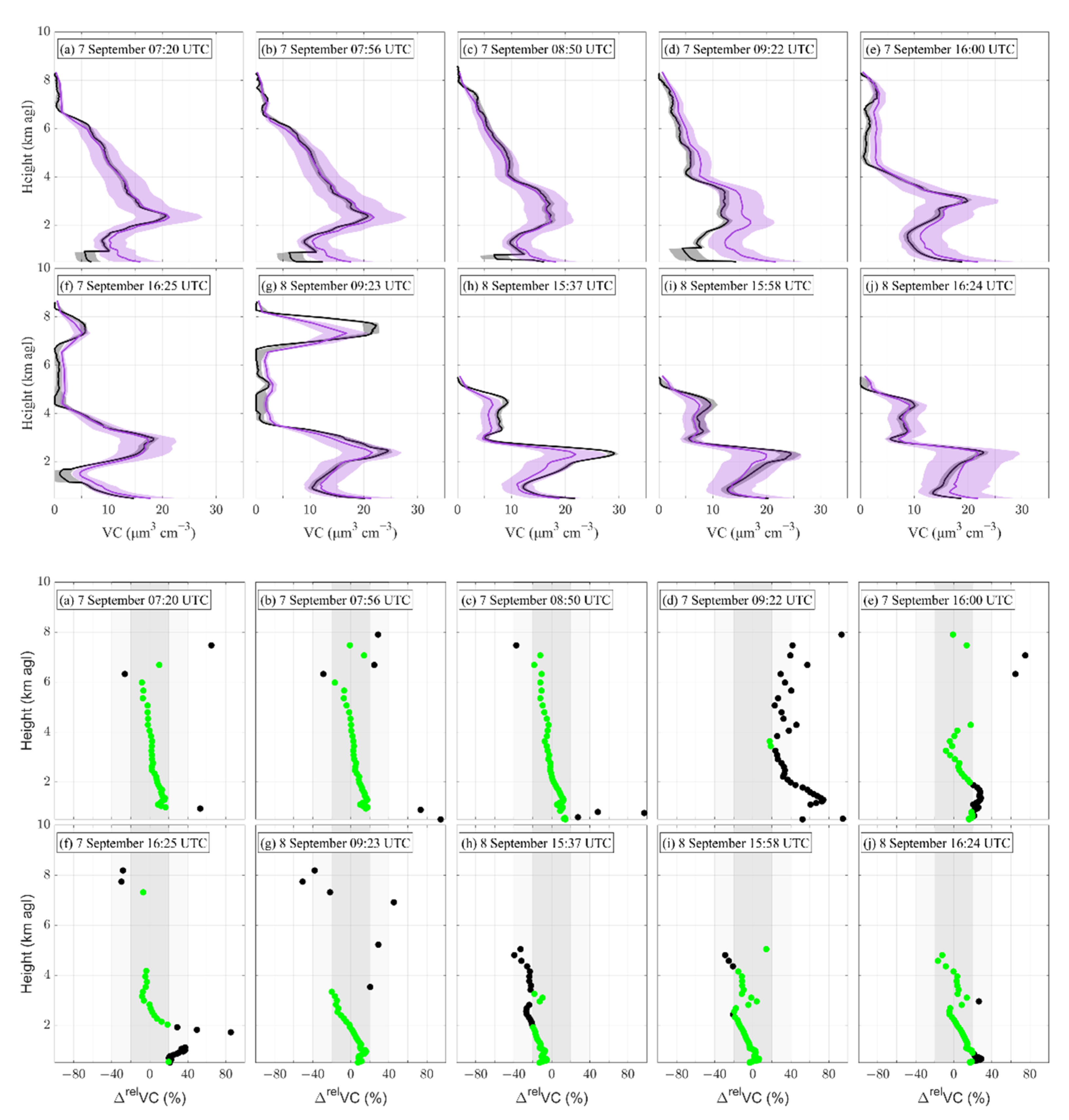
| Column-Integrated Data | Vertical Profiles |
|---|---|
| INPUTS | |
| Sky radiances (440, 675, 870, and 1020 nm) | Range-corrected signal (RCS, 532 nm) |
| AOD (440, 500, 675, 870, and 1020 nm) | |
| OUTPUTS | |
| Total Volume Concentration (VC) | Total Volume Concentration (VC(z)) |
| Total Effective Radius (Reff) | Total Backscatter Coefficient (βp(z)) |
| Particle Volume Size Distribution (VSD) | |
| Single Scattering Albedo (SSA) | |
| Complex Refractive Indexes (RRI, IRI) | |
| Date and Time (UTC) | AOD500 | AE440/675 | FMF500 | |
|---|---|---|---|---|
| 7 September 2017 | 07:20 | 0.26 | 1.75 | 0.92 |
| 07:56 | 0.26 | 1.76 | 0.92 | |
| 08:50 | 0.27 | 1.76 | 0.93 | |
| 09:22 | 0.29 | 1.73 | 0.93 | |
| 16:00 | 0.28 | 1.64 | 0.95 | |
| 16:25 | 0.28 | 1.61 | 0.96 | |
| 8 September 2017 | 09:23 | 0.40 | 1.53 | 0.98 |
| 15:37 | 0.29 | 1.66 | 0.97 | |
| 15:58 | 0.29 | 1.68 | 0.97 | |
| 16:24 | 0.29 | 1.67 | 0.97 | |
| BB Case (Date, Time) | Fine | Coarse | Total | |||||||||
|---|---|---|---|---|---|---|---|---|---|---|---|---|
| m | r | MFB (%) | χ (%) | m | r | MFB (%) | χ (%) | M | r | MFB (%) | χ (%) | |
| 7 September 2017 07:20 UTC | 1.24 (0.04) | 0.99 | −6.4 | 33 | 1.16 (0.13) | 0.94 | 31.8 | 54 | 1.19 (0.08) | 0.96 | 16.2 | 45 |
| 7 September 2017 07:56 UTC | 1.25 (0.03) | 0.99 | 6.6 | 33 | 1.21 (0.09) | 0.97 | 31.2 | 62 | 1.22 (0.06) | 0.98 | 21.1 | 50 |
| 7 September 2017 08:50 UTC | 0.91 (0.09) | 0.97 | −17.2 | 67 | 1.10 (0.08) | 0.97 | 14.8 | 62 | 0.99 (0.06) | 0.96 | 1.7 | 64 |
| 7 September 2017 09:22 UTC | 0.97 (0.08) | 0.98 | 8.8 | 67 | 1.11 (0.13) | 0.93 | 16.0 | 69 | 1.00 (0.07) | 0.96 | 13.0 | 68 |
| 7 September 2017 16:00 UTC | 0.63 (0.06) | 0.97 | −22.8 | 22 | 1.12 (0.14) | 0.92 | 12.1 | 54 | 0.66 (0.05) | 0.94 | −2.2 | 41 |
| 7 September 2017 16:25 UTC | 0.39 (0.08) | 0.87 | −63.9 | 11 | 1.08 (0.18) | 0.87 | 17.9 | 15 | 0.43 (0.07) | 0.80 | −15.6 | 14 |
| 8 September 2017 09:23 UTC | 1.30 (0.10) | 0.98 | 37.5 | 11 | 1.19 (0.09) | 0.97 | 18.8 | 46 | 1.28 (0.06) | 0.98 | 26.5 | 32 |
| 8 September 2017 15:58 UTC | 0.84 (0.08) | 0.97 | −12.8 | 56 | 1.12 (0.09) | 0.96 | 15.3 | 62 | 0.87 (0.06) | 0.96 | 3.8 | 59 |
| 8 September 2017 16:24 UTC | 1.27 (0.05) | 0.99 | 13.8 | 56 | 1.26 (0.05) | 0.99 | 27.8 | 46 | 1.26 (0.05) | 0.99 | 22.1 | 50 |
| Percentage of BB cases fulfilling high confidence conditions | 30% | 100% | 90% | 40% | 80% | 100% | 100% | 90% | 40% | 100% | 100% | 80% |
| Total Particle Backscatter Coefficient βp(z) (Mm−1 sr−1) | Total Volume Concentration VC(z) (μm3 cm−3) | |||||||
|---|---|---|---|---|---|---|---|---|
| Date, Time | m | r | MFB (%) | m | r | MFB (%) | ||
| 7 September 2017, 07:20 UTC | 0.91 (0.01) | 0.99 | −3.3 | 87 | 1.16 (0.04) | 0.97 | 28.0 | 58 |
| 7 September 2017, 07:56 UTC | 0.88 (0.01) | 0.99 | −9.6 | 82 | 1.18 (0.04) | 0.97 | 24.6 | 62 |
| 7 September 2017, 08:50 UTC | 0.82 (0.01) | 0.99 | −21.1 | 53 | 1.09 (0.03) | 0.99 | 12.9 | 82 |
| 7 September 2017, 09:22 UTC | 1.20 (0.02) | 0.99 | 20.3 | 42 | 1.58 (0.06) | 0.97 | 53.0 | 3 |
| 7 September 2017, 16:00 UTC | 1.01 (0.02) | 0.99 | 13.7 | 78 | 1.18 (0.02) | 0.99 | 28.8 | 45 |
| 7 September 2017, 16:25 UTC | 1.09 (0.03) | 0.98 | 32.2 | 52 | 1.20 (0.03) | 0.98 | 45.7 | 27 |
| 8 September 2017, 09:23 UTC | 1.07 (0.03) | 0.98 | 35.5 | 62 | 1.02 (0.02) | 0.98 | 31.2 | 67 |
| 8 September 2017, 15:37 UTC | 0.81 (0.02) | 0.98 | −18.9 | 38 | 0.90 (0.02) | 0.98 | −8.9 | 63 |
| 8 September 2017, 15:58 UTC | 0.82 (0.02) | 0.98 | −15.6 | 43 | 1.00 (0.02) | 0.98 | 2.8 | 83 |
| 8 September 2017, 16:24 UTC | 0.88 (0.02) | 0.98 | −7.2 | 60 | 1.19 (0.03) | 0.98 | 21.5 | 63 |
| Percentage of BB cases fulfilling high confidence conditions | 100% | 100% | 100% | 90% | 90% | 100% | 100% | 80% |
Publisher’s Note: MDPI stays neutral with regard to jurisdictional claims in published maps and institutional affiliations. |
© 2022 by the authors. Licensee MDPI, Basel, Switzerland. This article is an open access article distributed under the terms and conditions of the Creative Commons Attribution (CC BY) license (https://creativecommons.org/licenses/by/4.0/).
Share and Cite
López-Cayuela, M.-Á.; Herrera, M.E.; Córdoba-Jabonero, C.; Pérez-Ramírez, D.; Carvajal-Pérez, C.V.; Dubovik, O.; Guerrero-Rascado, J.L. Retrieval of Aged Biomass-Burning Aerosol Properties by Using GRASP Code in Synergy with Polarized Micro-Pulse Lidar and Sun/Sky Photometer. Remote Sens. 2022, 14, 3619. https://doi.org/10.3390/rs14153619
López-Cayuela M-Á, Herrera ME, Córdoba-Jabonero C, Pérez-Ramírez D, Carvajal-Pérez CV, Dubovik O, Guerrero-Rascado JL. Retrieval of Aged Biomass-Burning Aerosol Properties by Using GRASP Code in Synergy with Polarized Micro-Pulse Lidar and Sun/Sky Photometer. Remote Sensing. 2022; 14(15):3619. https://doi.org/10.3390/rs14153619
Chicago/Turabian StyleLópez-Cayuela, María-Ángeles, Milagros E. Herrera, Carmen Córdoba-Jabonero, Daniel Pérez-Ramírez, Clara Violeta Carvajal-Pérez, Oleg Dubovik, and Juan Luis Guerrero-Rascado. 2022. "Retrieval of Aged Biomass-Burning Aerosol Properties by Using GRASP Code in Synergy with Polarized Micro-Pulse Lidar and Sun/Sky Photometer" Remote Sensing 14, no. 15: 3619. https://doi.org/10.3390/rs14153619
APA StyleLópez-Cayuela, M.-Á., Herrera, M. E., Córdoba-Jabonero, C., Pérez-Ramírez, D., Carvajal-Pérez, C. V., Dubovik, O., & Guerrero-Rascado, J. L. (2022). Retrieval of Aged Biomass-Burning Aerosol Properties by Using GRASP Code in Synergy with Polarized Micro-Pulse Lidar and Sun/Sky Photometer. Remote Sensing, 14(15), 3619. https://doi.org/10.3390/rs14153619








